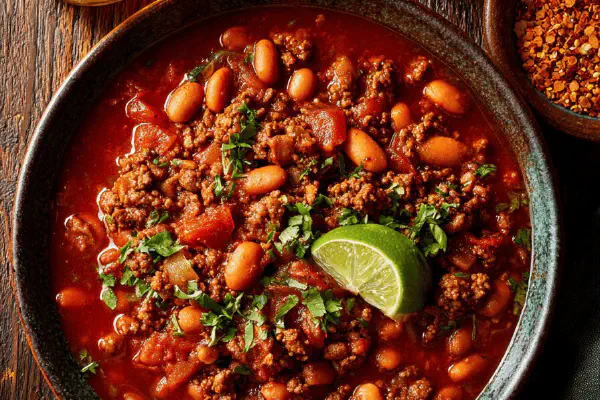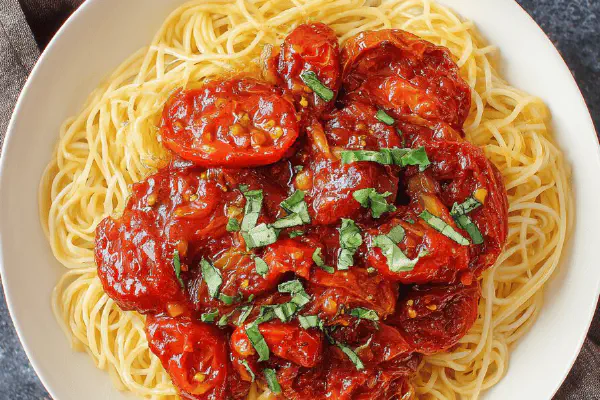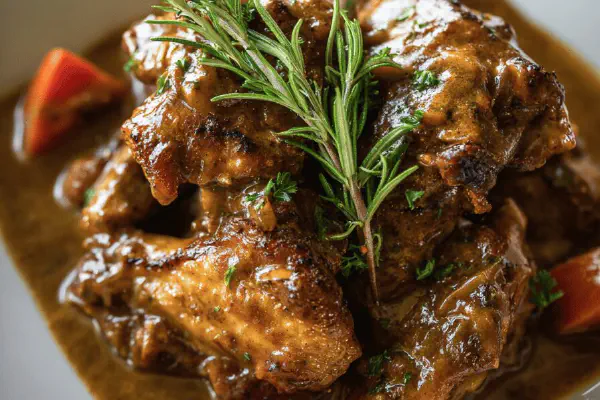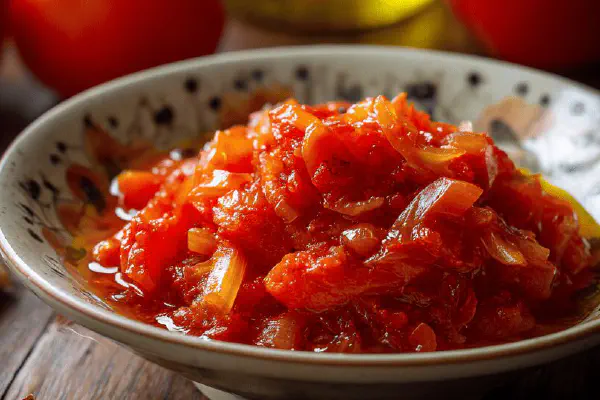Tangy Cran Blueberry BBQ
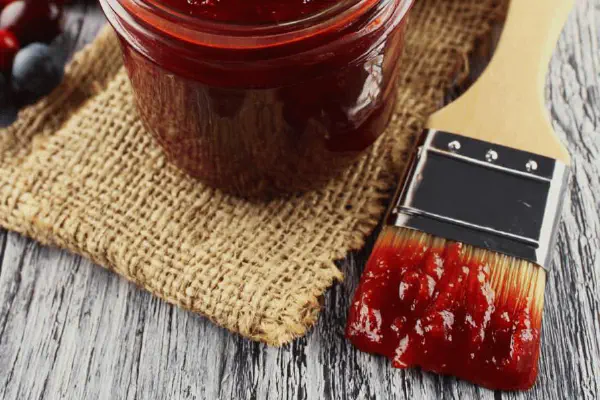
E
By Emma
Certified Culinary Professional
•
Recipe tested & approved
Smoky, fruity barbecue sauce combining dried ancho and chipotle chilis with tangy cranberries and fresh blueberries. Starts by rehydrating ancho pepper in hot coffee to extract deep, bitter notes and control heat. Onions softened in a hot pan bring sweetness and cut raw sharpness. Fruit and spices blended with reserved coffee and red wine simmered low and slow until thickened, syrupy edges scraped back in for full flavor. Use fresh or freeze portions. A versatile sauce with bold layers, balancing heat, acidity, and sweetness.
Prep:
35 min
Cook:
Total:
Servings:
4 servings
#BBQ
#barbecue sauce
#ancho chili
#coffee
#blueberries
#cranberries
#slow simmer
#American BBQ
#smoky sauce
#fruit BBQ sauce
Coffee and chilis. Not your usual BBQ hype. I stumbled on this combo for depth, bitterness that cuts tomato’s sweetness. Ancho soaked in hot coffee until it’s almost fragile—handle carefully or you end with pulp instead of flavor. Skipping spice removal wrecks balance; seeds are bomb heat bombs unless you want a blowtorch. Onion sweat soft, no color, keeps it honest. Pouring fruit purees into wine-ketchup-spice bath in double boiler feels fancy but keeps sauce silky, none of that tomato burn or raw fruit edge. Stirring long, low, scraping gooey edges back in—this is slow magic. Use fresh, freeze half, no waste. Sweet, tangy, smoky, and slightly bitter—all hugging your taste buds tight.
Ingredients
- 1 cup hot espresso or strong brewed coffee
- 1 dried ancho chili pepper
- Cooking spray or neutral oil spray
- 1 cup yellow onion, diced
- 1 chipotle chili in adobo (canned) or substitute 1 tsp smoked paprika + 1/2 tsp cayenne for milder heat
- 1 cup fresh blueberries
- 1/3 cup dried cranberries (can replace with dried cherries)
- 3 garlic cloves, roughly chopped
- 1/2 tsp ground cinnamon
- 1/4 tsp ground allspice
- 1/4 tsp ground cumin
- 2 tbsp ketchup (store-bought or homemade)
- 1 1/2 cups dry red wine (merlot or cabernet)
- Salt and pepper to taste
About the ingredients
Dried ancho chili soaks in coffee, slowly unlocking smoky bitterness and gentle heat. Coffee choice matters; espresso adds richness, but strong brewed works fine. Removing at least half the seeds controls heat—trust me on seeds, they dominate otherwise. Onions sautéed just until soft, no color to avoid bitterness. Chipotle chili provides smoky, spicy backbone; for less fiery, swap with smoked paprika and cayenne, blending smoky and mild heat. Fruit combo is key—fresh blueberries lend juiciness, dried cranberries tang. You can swap dried cranberries for cherries or raisins for personal tweaks. Ketchup binds flavors but keep it light to avoid tomato overload. Red wine adds acid and tannins; dry styles better here. If wine’s an issue, grape juice and vinegar can stand in, but sauce loses complexity. Spices cinnamon, allspice, and cumin warm the profile. Garlic is fresh and pungent, balancing fruit’s sweetness.
Method
- Begin by soaking the ancho chili in 1 cup hot coffee or espresso. The pepper softens quickly, almost falling apart. Use a fork to press down and make sure the whole pepper gets wet—don’t rush this. Once soaked, lift the pepper out reserving soaking liquid. Trim off the stem, dice roughly, and shake out at least half the seeds; seeds are pure heat and bitterness. Place the pepper pieces in a large food processor bowl.
- Lightly spray a small pan with cooking spray. Heat over medium until the spray starts to shimmer but not smoke—too hot burns onions fast. Add diced onion and sauté, stirring often, until translucent and tender, about 5-7 minutes. No browning here; just soft and sweet. Remove from burner and toss the onions in the food processor with the chipotle chili (chipotle add smoky depth, but substitute smoked paprika plus a pinch of cayenne if unavailable or want less intense heat).
- Add blueberries, dried cranberries, garlic cloves, and 1 cup of the reserved coffee from the ancho soak into the processor. Pulse several times to break down the fruit and pepper into a coarse, grainy puree—not too smooth. Texture matters; too smooth means missing the rustic feel—a little roughness gives a nicer mouthfeel.
- Now, set up a double boiler or a heatproof bowl over simmering water. Combine the spices: cinnamon, allspice and cumin, with ketchup and red wine in the top vessel. Stir to combine the sugar and acid from ketchup and wine, aromatic spices dispersing in the liquid. Slowly pour in the fruit-puree mixture. I usually split mine if my vessel is small—start with half and save the rest in a sealed container to freeze. Makes life easier, and sauce stays fresher that way.
- Simmer this mix gently, low heat is key—aggressive boiling ruins the flavor depth. Stir about every 10 minutes, watching for edges to thicken and turn syrupy. Scrap those crusty bits back into the pot to avoid waste and build more intense flavor. After 1.5 to 2 hours, the sauce should be rich, thick enough to coat a spoon with a slight sheen but still pourable.
- Use right away for glazing or dipping, or chill and freeze in portions. Freezing thick sauces in small containers prevents wasting leftovers. Thaw overnight in fridge and reheat gently before use. If thickened too much after cooling, thin with a splash of coffee or wine, stirring well.
- No perfect oven or fancy smoker needed here. Watch texture and aroma—if fruity notes start to dull or burn smells creep in, lower heat. Playing with coffee’s bitterness versus the sweetness of fruit keeps this sauce interesting. Adjust seeds for your heat tolerance; more seeds mean a hotter punch, but don't overdo or it gets harsh.
- Keep a small pan of water nearby while making the double boiler; too dry and sauce scorches. Stir often; the look of sauce pulling slightly away from sides signals done. Pour sauce onto ribs, brisket, grilled chicken, or for sandwiches. Bold, tangy, smoky with a little fruity surprise.
- Substitutions: dried cherries or tart raisins work for cranberries; fresh blackberries instead of blueberries are a tasty twist. Use instant coffee if short on brewed. Lacking red wine? Use grape juice plus a splash of vinegar instead, but skip wine’s depth and tannins so add more cinnamon or allspice.
- Failures happen if you rush soaking the pepper or overheat onions. Raw peppers taste woody; burnt onions add bitter notes. Texture too thin? Keep simmering or whisk in a little tomato paste. Too thick? Add reserved coffee or wine gradually.
- Patience here rewards the cook. This sauce isn’t about speed but layering flavors gently until they meld and thicken. Watching for subtle changes—the sauce’s scent changing from bright fruit to warm spices and rich coffee—is how you know you’re close to done.
Cooking tips
First, soak the ancho chile in hot coffee until it’s supple but intact. Timing isn’t exact—watch the pepper puff and soften. Use a fork to submerge fully—dry spots mean incomplete flavor extraction. Dice pepper, remove seeds cautiously to calibrate heat level. Cook onions gently over medium, sprayed pan to minimize sticking; onions become translucent and sweet, avoid browning for clean fruit highlight. Blend soaked chile, sautéed onion, chipotle, garlic, and fruit with reserved coffee, pulsing to a grainy puree—aim for texture, not baby food. Heat spices, ketchup, and wine in a double boiler, stirring well while slowly mixing in fruit blend to prevent lumps or burning. Cook low and slow, stirring every 10-15 minutes. Watch for syrupy edge buildup.
Chef's notes
- 💡 Soak ancho chili fully submerged in hot coffee or espresso then dice and remove at least half the seeds. Seeds pack bitterness and heat spikes. Use a fork to push down pepper ensuring no dry spots. Timing important—pepper fluff not fall apart. Flavor extracted is smoky with restrained heat if seeds managed right.
- 💡 Onion sauté needs low to medium heat with cooking spray to avoid browning. Browns bring bitter flavors that clash with fruit. Onions turn translucent soft, sweating out natural sugars for sweet base. Stir often but gentle, pan shimmering means just right heat. Pull from heat promptly to avoid carryover burn.
- 💡 Pulse fruit, garlic, soaked chili, and reserved coffee until coarse puree. Texture is key. Too smooth kills mouthfeel and rustic bite—want grainy bits to pop. Mixing coffee back adds depth, bitterness cuts through blueberry sweetness. Combine with chipotle or paprika-cayenne substitute to tune smoky heat level.
- 💡 Use double boiler for simmers. Combine cinnamon, allspice, cumin spices with ketchup and red wine first. Stir till spices bloom in liquid. Slowly add fruit blend to avoid lumps and scorching, especially important for fragile sugars in berries. Stir every 10 minutes to catch syrupy edges forming on sides—scrape back in to thicken sauce and build layers.
- 💡 Watch for sauce pulling away from pan sides and subtle sheen on spoon. Syrupy thickness but still pourable. If too thick later, loosen with coffee or wine splash slowly. Too thin? Keep simmering, add tomato paste if desperate. Low heat is crucial, high heat flattens aroma and risks burnt sourness. Patience needed to coax flavors.
Common questions
Can I use different coffee types?
Espresso richer but strong brewed okay. Instant coffee works but less depth. Avoid flavored coffees or sweetness modifiers. Black, hot, fresh preferred.
What if no red wine available?
Use grape juice plus vinegar but loses wine tannins and acid layers. Compensate with extra cinnamon or allspice for warmth. Skip if avoiding alcohol; just expect less complexity.
Why do onions burn sometimes?
High heat or pan too dry. Cooking spray helps but controlled flame more important. Onions should soften, not brown. Bitter burnt taste disrupts fruit brightness.
How long can I store sauce?
Refrigerate few days or freeze months. Use airtight container. Freeze in small portions recommended, reheating gentle with added coffee or wine keeps texture balanced.
